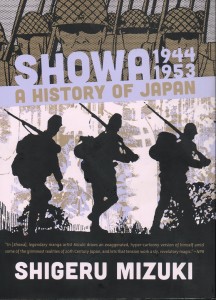Manga Review: Showa 1944 1953 a History of Japan by Shigeru Mizuki
Shigeru Mizuki was one of the oldest (born 1922, died 2015) still-working and most respected manga creators in Japan. Though he is best known for children’s horror comics such as GeGeGe no Kitaro, Mizuki also has written extensively for adults. This is the third volume of his personal history of Japan.
The first half of the volume covers the last bit of World War Two from the Japanese perspective, and Mizuki’s personal experiences as an infantry grunt in Papua New Guinea. After the failure of Japan’s invasion of India, and the successes of the Allies in the Pacific War, it is clear that the war had gone sour for the Greater East Asian Co-Prosperity Sphere, but Japan’s military leadership still believed they could pull a victory out of these difficult conditions.
On the ground, the military tried to keep up troop morale by emphasizing the idea of a “noble death”, taking as many Allies with you as possible rather than surrender or retreat. Mizuki survived by mere chance when his unit was ordered into a suicidal charge. He and the other survivors were considered an embarrassment to the brass, and their ill treatment became fictionalized as Onward Towards Our Noble Deaths, which I previously reviewed. Unlike his fictional counterpart, Mizuki survived even the worst, developing malaria and losing an arm.
Despite his condition, Mizuki was not repatriated to Japan until 1947, now under American occupation. General Douglas MacArthur and GHQ wanted to reform Japan and get it back on its feet, which among other things meant giving it a new constitution that prevented it from ever again going to war. New freedoms were the order of the day, until the occupiers realized what people wanted to do with those freedoms and began restricting them again.
Over a decade of war and its privations had ruined Japan’s economy, and all the returning soldiers didn’t help. As a disabled veteran, Mizuki was worse off than many others. Personal tragedy struck when his brother was imprisoned; the same deeds that had made him a war hero to the Japanese made him a war criminal to the Americans.
The Red Menace and the Korean War finally were the cause of Japan’s economy beginning to grow again as the Allied forces used it as their staging ground and pumped millions in aid into the area. Meanwhile, Mizuki had gone back to art school and become a kamishibai artist. (These were one-man shows where an entertainer would show pictures and tell stories to an audience, selling candy and snacks.) The advent of regular television was swiftly killing off the old ways, however….
The history is narrated by Nezumi-Otoko (Rat-man), one of Mizuki’s famous creations (joined by cameos of his fellow yokai monsters.) It’s mostly a visual convention as he does not act in his usual character. The art varies from cartoony to photo-realistic, sometimes on the same page, depending on the desired effect.
This is powerful stuff, depicting the horrors of war and occupation, and a few brief moments of peace and joy wrested from their midst. There’s some nudity, and mentions of rape and prostitution (nothing about Mizuki’s own sex life–it’s possible he simply didn’t have any to speak of in this period.) I would suggest it to no younger than senior high students, and even then advise caution.
There’s an introduction by manga scholar Frederik L. Shodt, and end notes explaining who many of the historical figures are, and other useful details.
Despite its disturbing nature, this will be a valuable volume for history buffs and those who want more information on the decade or so covered in this book. Highly recommended.

